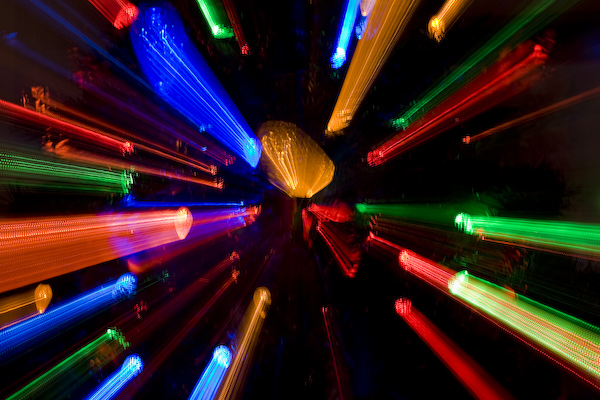Experiments with Christmas Lights
Some months ago I presented a series of works on long exposures with aerial fireworks (see this, that, and the other). Here I’ve applied some similar techniques to photographing stationary lights on a Christmas tree.
With this image, I put the camera on a tripod and used a 100-300mm telephoto zoom on a full-frame (like 35mm) digital camera. I put the lens at the 300mm focal length, manually focused, set the lens back to the 100mm focal length, and set the exposure at -2 f-stops (to help make a dark background) with a small aperture (f/8, to give me a long exposure). Once the shutter opened, I started zooming inward toward the 300mm focal length. I reached the 300mm setting before the end of the exposure, and that lingering moment provided enough time to define a still rendition of some of the bulbs.
Other experiments in this series included stopping momentarily 3 or 4 times during the zooming, producing multiple still images of the bulbs along their streaks of color. I also tried defocusing while zooming (to get broader strokes of color), as well as photographing smaller light bulbs (which ended up looking more like fireworks than Christmas lights). Another variation on this theme was composing the frame so that no lights were in the center. The other effects were interesting, but this (simpler) image was the one my in-house critics liked the best.
The bulbs on the tree are the 7-watt size (which is a retro movement from the recent trend of very small lights we’ve been seeing on houses and trees). These bigger bulbs serve as larger brushes for painting their colors, and the colors are more saturated. You may also notice that the lines of color are dotted instead of continuous — these are LED (Light-Emitting Diode) bulbs which pulsate at 60 Hz, the frequency of the AC power. These LED bulbs consume a small fraction of the power of their incandescent counterparts.

Tip of the Week
2007.12.03

